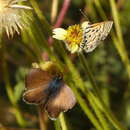en
names in breadcrumbs


Frequent
Azanus jesous is very active, and always fly very low, just above the grasses. It nectar eagerly at any available wild flowers and fixedly keep their wings held erect when feeding.
Size: 18-24 mm. Azanus jesous is small blue and finely-marked butterfly . Male has transparent shiny blue scales on the upperside of the wing, allowing darker areas of the underside of the wing to show through, and giving it a striped appearance; the underside of the wing is a delicate violet-blue, and it has lilac-blue wings with black margins.The upperside of the wing in female is mostly brown with dusting of pale blue scales towards wing bases, and also have a variable, white, disc-shaped patch, an obvious brown spot near the tips, and a black spot near the body. The undersides of the wings on both male and female have broad, straight, white-edged bands on the forewings and a group of white-edged, brown spots on the hindwings.
Sinai. Larsen (1990) suggests probably Gebel Elba as well. AOO = 38 km2. EOO = 156,000 km2. 3 locations.
Widespread (most of dry Africa, Egypt, Syria, Ceylon, India, Burma, across the entire African continent including Madagascar, and in Asia from Pakistan, India and Sri Lanka to Burma).
Adults fly very actively around acacia, settling suddenly; males come readily to bird droppings and wet soil. This species is found in dry grassy habitats ranging from deserts, steppes, savannahs and thorn scrub, to clearings in the drier forests.
Not Assessed ( not an Egyptian resident)
Two generations per year.
9 known records. Latest in 2001 (from South Sinai)
Larsen (1990) suggests it is a migrant
February-October
Not known any threats .
Host-plants: Acacia species, Prosopis farcta (Leguminosae).
Azanus jesous, the African babul blue[2] or topaz-spotted blue,[3] is a small butterfly found in Africa, Egypt, Syria, India,[2] Sri Lanka and Myanmar[1] that belongs to the lycaenids or blues family.

The male upperside is a paler and much brighter purple than in A. ubaldus, the dark blue tint at the base of the wings is more pronounced. Forewing: without the clothing of specialized hair-like scales so conspicuous in A. ubaldus. Hindwing: with the dark tornal spots very obscure. Forewings and hindwings: with only slender dark anteciliary lines, but no regular brown edging. Underside: dull pale grey. Forewing: costal margin brown, a black white-encircled spot in cell, a dark chestnut-brown streak between vein 12 and subcostal vein; similarly coloured but somewhat paler transverse bars cross the upper discal area of the wing as follows: one on the discocellulars and three beyond, each bar edged internally and externally with white; below this two elongate brownish white-edged spots placed en echelon and beyond a slender, unbroken, transverse, postdiscal brown line; a transverse subterminal series of black spots, each surrounded with white, and a slender anteciliary dark line. In most specimens there is also a dusky spot below the cell near the base of the wing.[4]
Hindwing: an outwardly oblique short streak from base of cell, a spot below it, a transverse subbasal series of four spots and a complete series of subterminal spots in interspaces 1, 2, 4, 5, 6, and 7, jet-black, each spot surrounded with white; the subterminal spot in interspace 3, a terminal small spot in interspace 7, an outwardly-oblique discal line of six elongate spots, the anterior spot shifted inwards out of line, and a transverse line beyond apex of cell, dark brown, each of these markings margined with white; on the terminal area there is an inner subterminal lunulated dark line on the inner side of the series of black spots and an anteciliary similar slender line. Cilia white, basal halves brown; on the forewing interrupted also with brown at the apices of the veins. Antennae, head, thorax and abdomen dark brown; shafts of the antennas white ringed, thorax with a little bluish pubescence; beneath: palpi, thorax and abdomen white.[4]
Female upperside: milky brown, bluish at the base of the wings. Forewing: a large dark brown discocellular transverse spot and a small quadrate white patch beyond. Hindwing: some two or three obscure dark subterminal spots towards the tornus. In some specimens the series complete from apex to tornus, more obscure anteriorly than posteriorly. Forewings and hindwings: both with slender dark anteciliary line. Underside: ground colour slightly paler, but the markings very similar to those in the male; the transverse brown bars beyond apex of cell on the forewing longer, almost extended to the dorsal margin. Cilia, antennae, thorax and abdomen much as in the male.[4][5]
Azanus jesous, the African babul blue or topaz-spotted blue, is a small butterfly found in Africa, Egypt, Syria, India, Sri Lanka and Myanmar that belongs to the lycaenids or blues family.